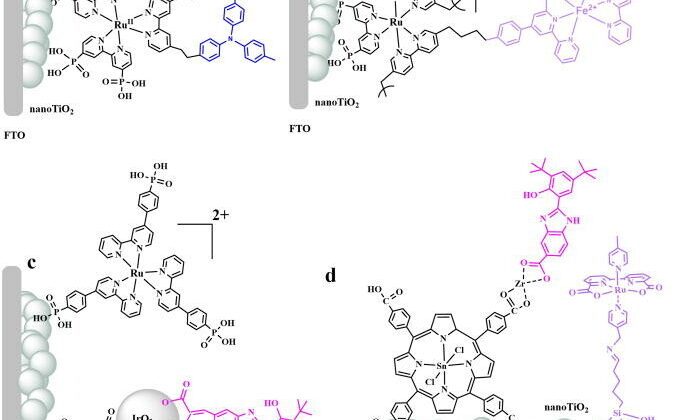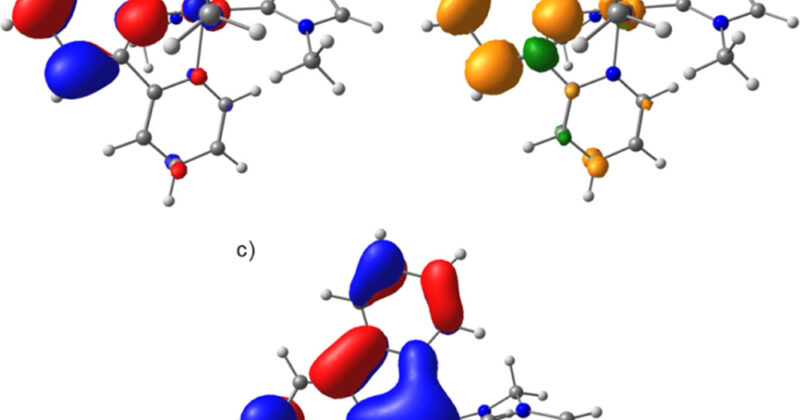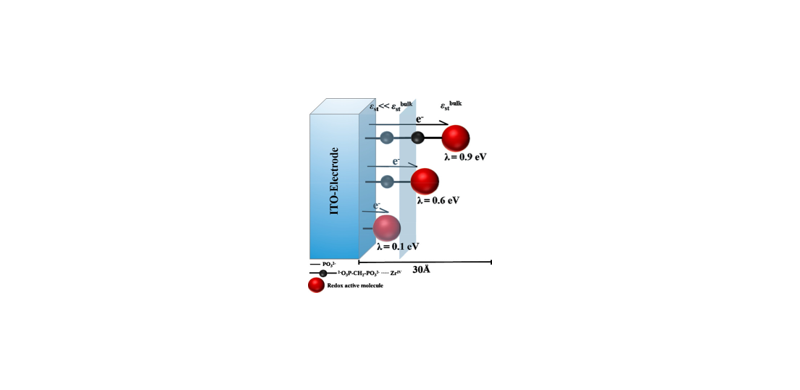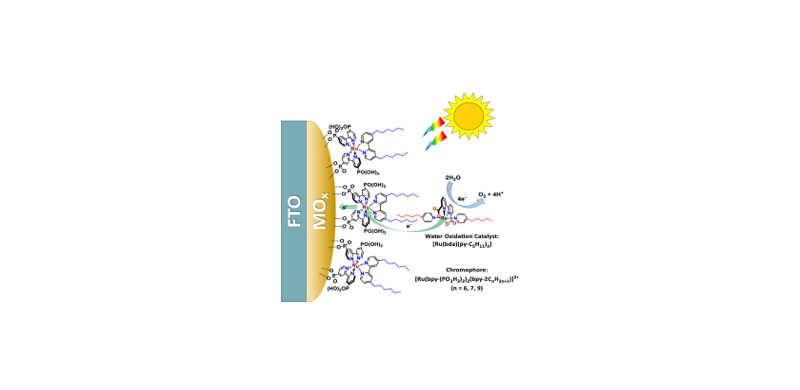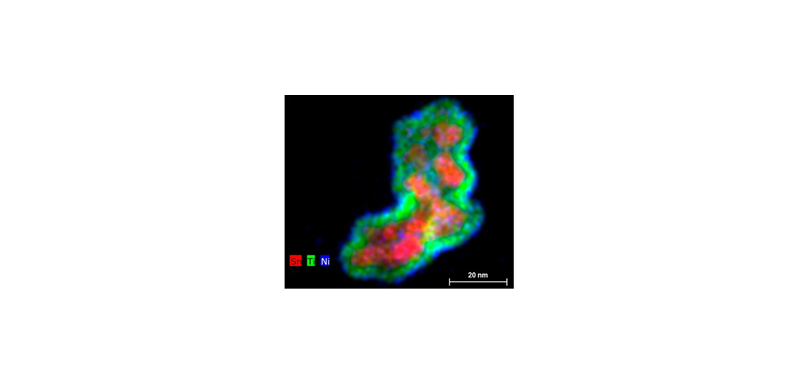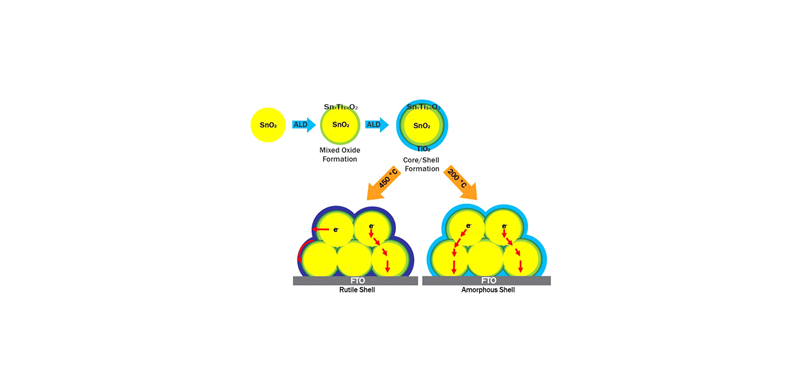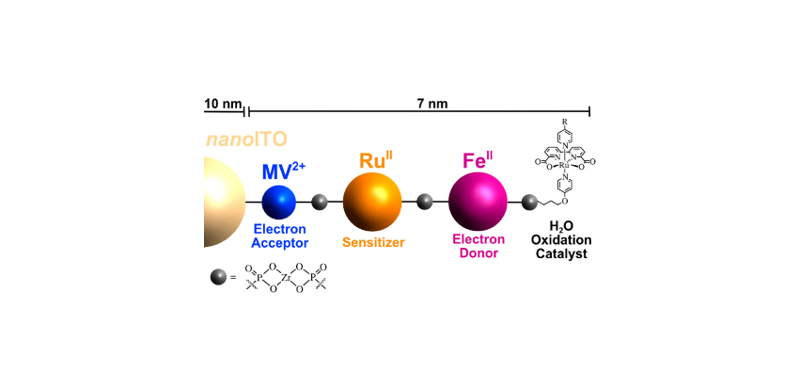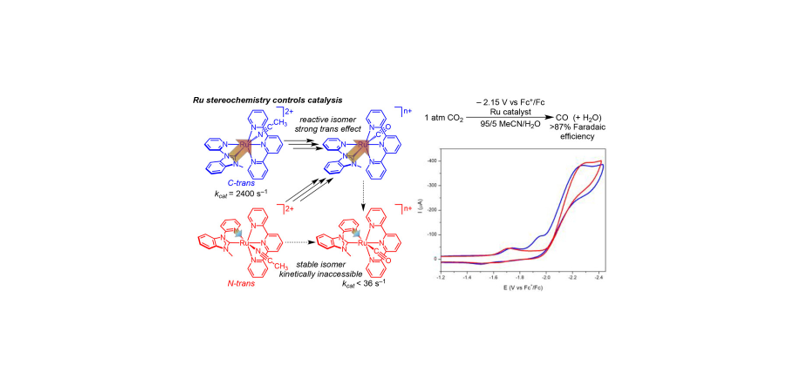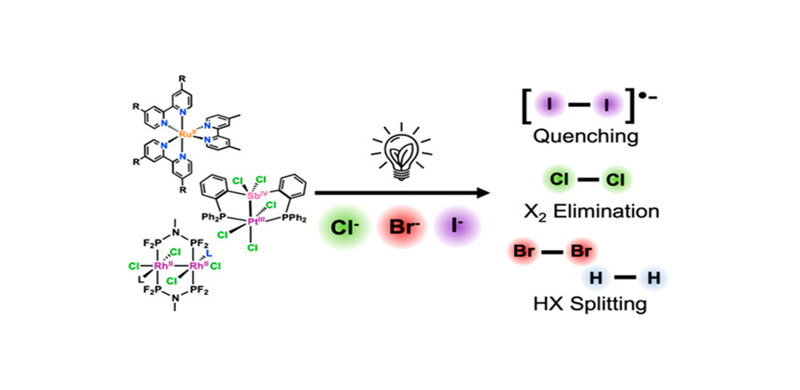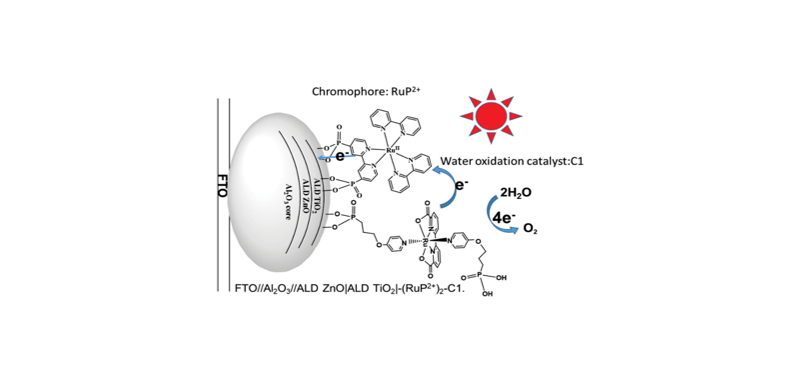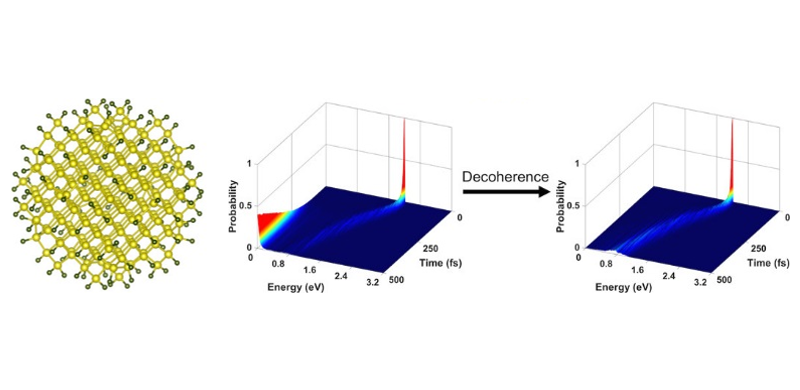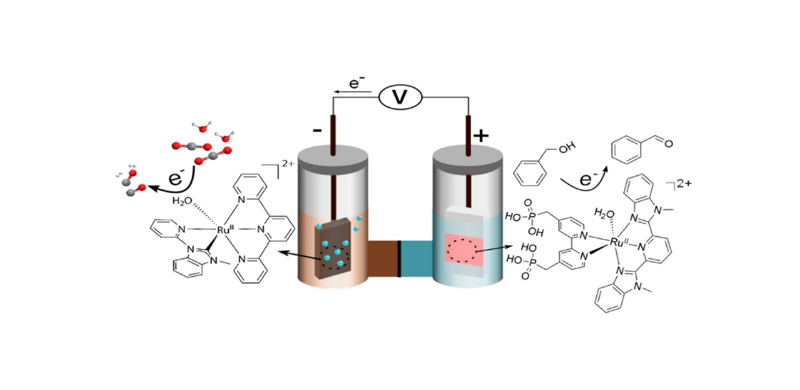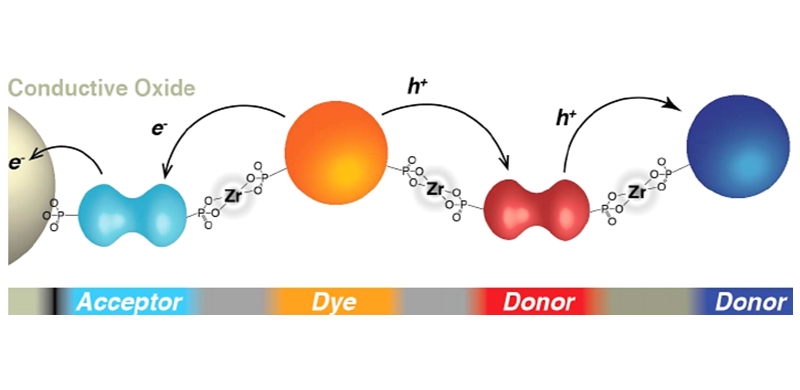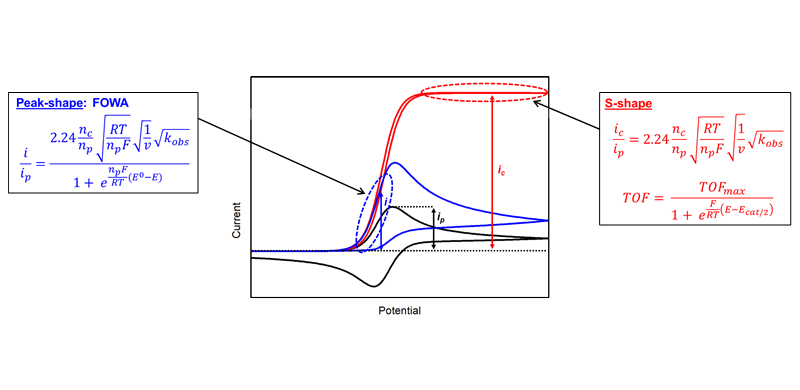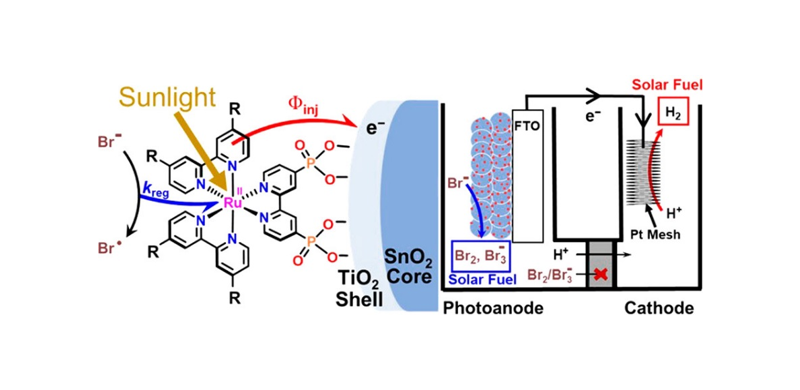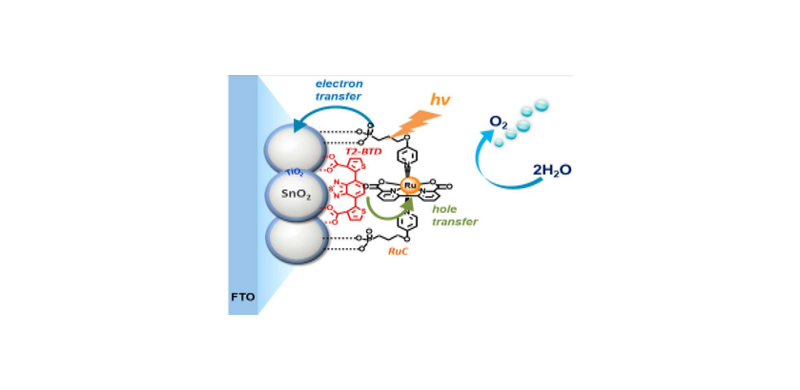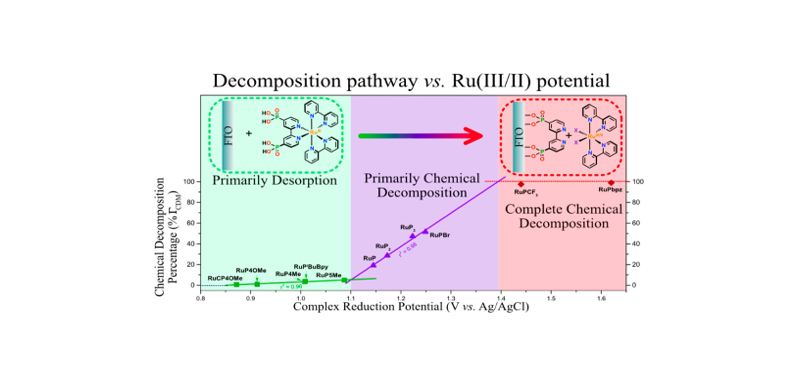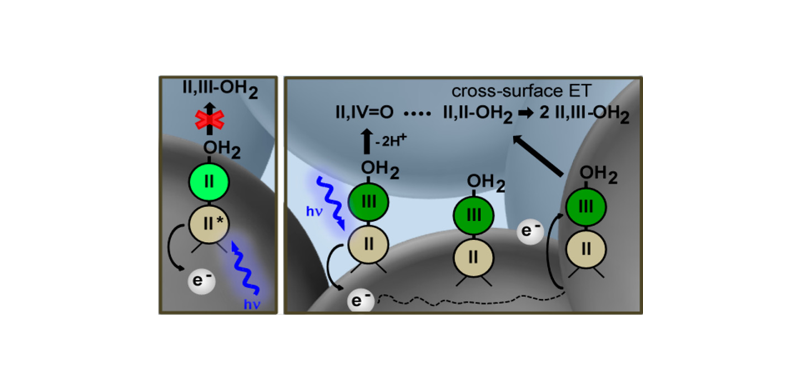Publications
New Paper – A Semiconductor-Mediator-Catalyst Artificial Photosynthetic System for Photoelectrochemical Water Oxidation
In fabricating an artificial photosynthesis (AP) electrode for water oxidation, we have devised a semiconductor-mediator-catalyst structure that mimics photosystem II (PSII). It is based on a surface layer of vertically grown nanorods of Fe2O3 on fluorine doped tin oxide (FTO) electrodes … Read more
New Paper – Design and characterization of surface molecular assemblies for the preparation of solar fuels
A key issue in solar energy conversion is the utilization of solar energy for the preparation of solar fuels. In this area, artificial photosynthesis offers promising approaches for the conversion of H2O and CO2 into usable solar fuels. This review … Read more
New Paper – An Iron Bis(carbene) Catalyst for Low Overpotential CO2 Electroreduction to CO: Mechanistic Insights from Kinetic Zone Diagrams, Spectroscopy, and Theory
A common challenge in molecular electrocatalysis is the relationship between maximum activity and the overpotential required to reach that rate, with faster catalysts incurring higher overpotentials. This work follows a strategy based on independent tuning of ligands in the primary … Read more
New Paper – Mixed Tin-Titanium Oxides by Atomic Layer Deposition on Planar Substrates: Physical and Electronic Structure
Ternary atomic layer deposition of Sn-doped TiOx (Sn:TiOx) and Ti-doped SnOx (Ti:SnOx) was performed using tetrakisdimethylamidotitanium (IV) and tin(IV) with water at 150 °C on (1 0 0) Si and quartz substrates. The physical structure of the films was investigated using scanning electron, atomic force, … Read more
New Paper – Influence of Surface and Structural Variations in Donor−Acceptor−Donor Sensitizers on Photoelectrocatalytic Water Splitting
Conjugated organic chromophores composed of linked donor (D) and acceptor (A) moieties have attracted considerable attention for photoelectrochemical applications. In this work, we compare the optoelectronic properties and photoelectrochemical performance of two D–A–D structural isomers with thiophene-X-carboxylic acid (X denotes 3 … Read more
New Paper – Polymer Chromophore-Catalyst Assembly for Photocatalytic CO2 Reduction
A polystyrene-based chromophore–catalyst assembly (PS-RuC/RuCat) was synthesized and applied for photocatalytic CO2 reduction in an organic solution in the presence of a sacrificial donor. The polymer assembly contains Ru(bpy)32+ (RuC, bpy = 2,2′-bipyridine) as the chromophore and a derivative of … Read more
New Paper – Interfacial Electron Transfer through Ultrathin ALD TiOX Layers: A Comparative Study of TiO2/TiOX and SnO2/TiOX Core/Shell Nanocrystals
Mesoporous anatase TiO2, mixed anatase/brookite TiO2, and rutile-type SnO2 nanocrystalline films were coated with ultrathin (<5 nm) TiOx by the atomic layer deposition (ALD) of tetrakisdimethylamidotitanium(IV) and water at 150 °C to fabricate SnO2/TiOx and TiO2/TiOx core/shell materials. The core/shell … Read more
New Paper – It Is Good to Be Flexible: Energy Transport Facilitated by Conformational Fluctuations in Light-Harvesting Polymers
We investigate the mechanism of energy transfer between ruthenium(II) (Ru) and osmium(II) (Os) polypyridyl complexes affixed to a polyfluorene backbone (PF-RuOs) using a combination of time-resolved emission spectroscopy and coarse-grained molecular dynamics (CG MD). Photoexcitation of a Ru chromophore initiates … Read more
New Paper – Dye-Sensitized Nonstoichiometric Strontium Titanate Core-Shell Photocathodes for Photoelectrosynthesis Applications
A core/shell approach that utilizes a high-surface area conducting core and an outer semiconductor shell is exploited to prepare p-type dye-sensitized solar energy cells that operate with a minimal applied bias. Photocathodes were prepared by coating thin films of nanocrystalline … Read more
New Paper – An Iron Pyridyl-Carbene Electrocatalyst for Low Overpotential CO2 Reduction to CO
Electrocatalysts for CO2 reduction based on first-row transition metal ions have attracted attention as abundant and affordable candidates for energy conversion applications. Yet very few molecular iron electrocatalysts exhibit high selectivity for CO. Iron complexes supported by a redox-active 2,2′:6′,2″-terpyridine … Read more
New Paper – Tunneling and Thermally Activated Electron Transfer in Dye-Sensitized SnO2|TiO2 Core|Shell Nanostructures
The mechanism for interfacial electron transfer (ET) from a metal oxide core|shell nanostructure to a [RuIII(2,2′-bipyridine)2(4,4′-(PO3H2)2-2,2′-bipyridine)]3+ sensitizer was probed through spectroscopic quantification of the ET kinetics over a 70 °C temperature range in an aqueous 0.1 M HClO4 solution. Mesoporous thin films … Read more
New Paper – Enabling Aqueous NiO Photocathodes by Passivating Surface Sites That Facilitate Proton-Coupled Charge Transfer
Photoelectrodes consisting of wide-band gap metal oxides functionalized with chromophores and catalysts are a potential low-cost solution to generate solar fuels from aqueous solution. NiO is a common photocathode material used in these systems, yet it generally exhibits poor performance … Read more
New Paper – Organic Chromophores Designed for Hole Injection into Wide-Band-Gap Metal Oxides for Solar Fuel Applications
The power conversion efficiency of tandem dye-sensitized photoelectrosynthesis cells is limited by the number of p-type metal oxide semiconductors and chromophores available for the photocathode. Here, a new class of donor–acceptor–donor organic chromophores is introduced with deep highest occupied molecular … Read more
New Paper – Solvent influence on non-adiabatic interfacial electron transfer at conductive oxide electrolyte interfaces
The kinetics for interfacial electron transfer (ET) from a transparent conductive oxide (tin-doped indium oxide, ITO, Sn:In2O3) to molecular acceptors 4-[N,N-di(p-tolyl)amino]benzylphosphonic acid, TPA, and [RuII(bpy)2(4,4′-(PO3H2)2-bpy)]2+, RuP, positioned at variable distances within and beyond the electric double layer (EDL), were quantified … Read more
New Paper – Perspectives on Dye Sensitization of Nanocrystalline Mesoporous Thin Films
Recent advances in our mechanistic understanding of dye-sensitized electron transfer reactions occurring at metal oxide interfaces are described. These advances were enabled by the advent of mesoporous thin films, comprised of anatase TiO2 nanocrystallites, that are amenable to spectroscopic and … Read more
New Paper – Ultrafast Energy Transfer in Fully Conjugated Thiophene-Benzothiadiazole Capped Poly(Phenylene Ethynylene) Molecular Wires
Energy transfer was explored in a series of poly(phenylene ethynylene) (PPE) polymers with increasing lengths that were end-capped with thiophene-benzothiadiazole (TBT) groups to form fully conjugated donor–acceptor polymers. For the polymers in solution, ultrafast transient absorption and time-resolved fluorescence spectroscopy … Read more
New Paper – Photophysical characterization of new osmium (II) photocatalysts for hydrohalic acid splitting
Two osmium(II) photocatalysts bearing a dicationic 4,4′-bis-(trimethylaminomethyl)-2,2′-bipyridine (tmam) ligand and 2,2′-bipyridine {[Os(bpy)2(tmam)]4+} or 4,4′-(CF3)2-2,2′-bipyridine {[Os((CF3)2bpy)2(tmam)]4+} ancillary ligands were synthesized and characterized for application in HX splitting. Iodide titration studies in acetone solutions provided evidence for an in situ formed terionic complex with two iodide … Read more
New Paper – Kinetic Evidence that the Solvent Barrier for Electron Transfer is Absent in the Electric Double Layer
Classical capacitance studies have revealed that the first layer of water present at an aqueous metal-electrolyte interface has a die-lectric constant less than 1/10th that of bulk water. Modern theory indicates that under such solvent conditions the barrier for elec-tron … Read more
New Paper – Abrupt degenerately-doped silicon nanowire tunnel junctions
The presence of narrow, degenerately-doped axial silicon nanowire (SiNW) p–n junctions via off-axis electron holography (EH) has been confirmed. SiNWs were grown via the vapor-solid-liquid (VLS) mechanism using gold (Au) as the catalyst, silane (SiH4 ), diborane (B2H6 ) and phosphine (PH3 ) as the … Read more
New Paper – Ultrafast Relaxations in Ruthenium Polypyridyl Chromophores Determined by Stochastic Kinetics Simulations
Maximizing the efficiency of solar energy conversion using dye assemblies rests on understanding where the energy goes following absorption. Transient spectroscopies in solution are useful for this purpose, and the time-resolved data are usually analyzed with a sum of exponentials. … Read more
New Paper – Kinetics of the Trans Effect in Ruthenium Complexes Provide Insight into the Factors that Control Activity and Stability in CO2 Electroreduction
Comparative kinetic studies of a series of new ruthenium complexes provide a platform for understanding how strong trans effect ligands and redox-active ligands work together to enable rapid electrochemical CO2 reduction at moderate overpotential. After synthesizing isomeric pairs of ruthenium … Read more
New Paper ‒ Cation Effects in p-Type Dye Sensitized Solar Cells
The performance of dye sensitized solar cells (DSSCs) depends on the properties and interactions of three fundamental components: the semiconductor, chromophore, and electrolyte. For the electrolyte, the dependence of DSSC performance on the identity and valence state of the spectator … Read more
New Paper ‒ BODIPY Dyes as Visible Light Absorber/Sensitizers on Semiconductor Oxide Surfaces
The synthesis, characterization, electrochemical and photophysical properties of the phosphonate-derivatized Carbazole (CBZ) and boron dipyrromethene (BODIPY) chromophores in the dyes, BODIPY(CBZ)2PO3H2 [8] and BODIPY(Tol)2PO3H2 [7], are described. The oxide-bound dyes have been explored as light absorbers in dye-sensitized photoelectrosynthesis cell … Read more
New Paper ‒ Electron Transfer Reorganization Energies in the Electrode–Electrolyte Double Layer
The total reorganization energy, λ, for interfacial electron transfer, ET, from a conductive electrode to redox-active molecules at fixed positions within the electric double layer, EDL, has been determined experimentally. Conductive indium–tin-oxide (ITO, In2O3:Sn) mesoporous films were functionalized with 4-[N,N-di(p-tolyl)-amino]benzylphosphonic … Read more
New Paper ‒ Self-Assembled Chromophore/Catalyst Bilayer for Water Oxidation in a Dye-Sensitized Photoelectrosynthesis Cell
A new approach is described for the preparation of water oxidation photoanodes in a Dye-Sensitized Photoelectrosynthesis Cell (DSPEC) for water splitting. It is based on a chromophore (C) – catalyst (Cat) assembly prepared by a self-assembled bilayer (SAB) on a … Read more
New Paper ‒ Factors that Control the Direction of Excited State Electron Transfer at Dye-Sensitized Oxide Interfaces
Molecular excited states at conductive and semiconductive interfaces were found to transfer an electron to the oxide (injection) or accept an electron from the oxide (hole transfer). The direction of this electron transfer was determined by the metal oxide electronic … Read more
New Paper ‒ A stable dye-sensitized photoelectrosynthesis cell mediated by a NiO overlayer for water oxidation
In the development of photoelectrochemical cells for water splitting or CO2 reduction, a major challenge is O2 evolution at photoelectrodes that, in behavior, mimic photosystem II. At an appropriate semiconductor electrode, a water oxidation catalyst must be integrated with a visible … Read more
New Paper ‒ Electron Localization & Transport in SnO2/TiO2 Mesoporous Thin Films
A study of SnO2/TiO2 core/shell films was undertaken to investigate the influence of shell thickness and post deposition sintering on electron localization and transport properties. Electrochemical reduction of the materials resulted in the appearance of a broad visible –near IR … Read more
New Paper ‒ Atomic Layer Deposition of SnOx onto Mesoporous, Nanocrsytalline TiO2 and SnO2 Thin Films
The atomic layer deposition of tetrakisdimethylamidotin(IV) and water on mesoporous thin films of nanocrystalline anatase TiO2, rutile SnO2, and rutile TiO2 was investigated. For all deposition conditions tested, highly oxygen deficient coatings were created, and purge time and temperature were … Read more
New Paper ‒ Proton-Coupled Electron Transfer in Water Oxidation Catalysis
The reorganization energy, λ, for interfacial electron transfer (ET) and for proton-coupled electron transfer (PCET) between a water oxidation catalyst and a conductive In2O3:Sn (ITO) oxide were extracted from kinetic data by application of Marcus–Gerischer theory. Specifically, light excitation of … Read more
New Paper ‒ Modeling Electron Injection at Semiconductor-Molecule Interfaces
Excited electron transfer across semiconductor-molecule heterogeneous interfaces is central to various future electronic and optoelectronic devices. At the same time, first-principles modeling of such dynamical processes remains as a great challenge in theoretical chemistry and condensed matter physics for developing … Read more
New Paper ‒ Molecular Photoelectrode for Water Oxidation Inspired by Photosystem II
In artificial photosynthesis, the sun drives water splitting into H2 and O2 or converts CO2 into a useful form of carbon. In most schemes, water oxidation is typically the limiting half-reaction. Here, we introduce a molecular approach to the design … Read more
New Paper ‒ Trans Effect in Electrocatalytic CO2 Reduction
A comprehensive mechanistic study of electrocatalytic CO2 reduction by ruthenium 2,2′:6′,2″-terpyridine (tpy) pyridyl-carbene catalysts reveals the importance of stereochemical control to locate the strongly donating N-heterocyclic carbene ligand trans to the site of CO2 activation. Computational studies were undertaken to … Read more
New Paper ‒ A Donor-Chromophore-Catalyst Assembly for Solar CO2 Reduction
This paper describes the preparation and characterization of a photocathode assembly for CO2 reduction to CO in 0.1M LiClO4 acetonitrile. The assembly was formed on 1.0 µm thick mesoporous films of NiO using a layer-by-layer procedure based on Zr(IV)-phosphonate bridging … Read more
New Review ‒ Halide Photoredox Chemistry
Halide photoredox chemistry is of both practical and fundamental interest. Practical applications have largely focused on solar energy conversion with hydrogen gas, through HX splitting, and electrical power generation, in regenerative photoelectrochemical and photovoltaic cells. On a more fundamental level, … Read more
New Paper ‒ Light-driven Water Oxidation on a Mesoporous Double-Shell Electrode
A mesoporous atomic layer deposition (ALD) double-shell electrode, Al2O3 (insulating core)//ALD ZnO|ALD TiO2, on a fluorine-doped tin oxide (FTO) conducting substrate was explored for a photoanode assembly, FTO//Al2O3 (insulating core)//ALD ZnO|ALD TiO2|–chromophore–catalyst, for light-driven water oxidation. Photocurrent densities at photoanodes based on … Read more
New Paper ‒ Decoherence in Hot Electron Relaxation within Fluorinated Silicon Quantum Dots
Surface passivation with fluorine atoms results in a significant slow down of hot electron relaxation because there exist particular electronic states that retain the hot electron for an extended time, and the relaxation time scale is largely influenced by shuttling … Read more
New Paper ‒ Simultaneous Electrosynthesis of Syngas and an Aldehyde
A tandem cell for artificial photosynthesis with CO2 and water as the oxidants and an organic alcohol as the reductant is described. The use of molecular catalysts with high activity and selectivity, in an appropriate cell configuration, leads to electrochemical reduction … Read more
New Paper ‒ A Silane-Derivatized Ru(II) Catalyst for Water Oxidation
The silane-derivatized catalyst, Ru(bda)(L)2 (bda = 2,2′-bipyridine-6,6′-dicarboxylate, L = 4-(6-(triethoxysilyl)hexyl)pyridine), is stabilized on metal oxide electrode surfaces over an extended pH range. It maintains its reactivity on the electrode surface toward electrochemical oxidation over a wide range of conditions. On … Read more
New Paper ‒ A Charge‐Separated State that Lives for Almost a Second
Transparent conductive oxides (TCOs) are widely-used commercially available materials for opto‐electronic applications, yet have received very little attention for dye‐sensitization applications. This paper reports that mesoporous thin films of conductive indium‐doped tin oxide (ITO) nanocrystallites support long‐lived charge separation with … Read more
New Review ‒ Carbon Dioxide Electroreduction
The development of molecular organometallic electrocatalysts for the reduction of carbon dioxide (CO2) is reviewed. Organometallic complexes are a promising subset of the many catalysts capable of electrochemical reduction of carbon dioxide to organic small molecules such as carbon monoxide (CO), formate (HCO2−), and oxalate (C2O42−). The carbon-based supporting ligands of organometallic complexes … Read more
New Paper ‒ Optimization of Photocatalyst Reduction Potentials for Dye-Sensitized HBr Splitting
Dye-sensitized bromide oxidation was investigated using a series of ruthenium polypyridyl photocatalysts anchored to SnO2/TiO2 core/shell mesoporous thin films through 2,2’-bipyridine-4,4’-diphosphonic acid anchoring groups. The ground- and excited-state reduction potentials were tuned over 500 mV by the introduction of electron-withdrawing … Read more
New Paper ‒ Stabilized Photoanodes for Water Oxidation
Stabilized photoanodes for light-driven water oxidation were prepared on nanoparticle core/shell electrodes with surface-stabilized donor–acceptor chromophores, a water oxidation catalyst, and an electron-transfer mediator. For the electrode, fluorine-doped tin oxide FTO|SnO2/TiO2|-Org1-|1.1 nm Al2O3|-RuP2+-WOC (water oxidation catalyst) with Org1 (1-cyano-2-(4-(diphenylamino)phenyl)vinyl)phosphonic acid), … Read more
New Paper ‒ Photocatalytic Water Oxidation by a π-Conjugated Chromophore-Catalyst Assembly
The organic chromophore, 2,2′-(benzo[c][1,2,5]thiadiazole-4,7-diyl)bis(thiophene-3-carboxylic acid), was prepared and investigated along with metal complex [Ru(bda)(pyP)2] (bda = 2,2’-bipyridine-6,6’-dicarboxylate; pyP = 3-(pyridine-4-yloxy)propyl)phosphonic acid), for light-driven water splitting in dye-sensitized photoelectrochemical cells. The resulting co-loaded organic chromophore plus catalyst surface assembly was evaluated … Read more
New Paper ‒ Completing a Charge Transport Chain for Artificial Photosynthesis
A ruthenium polypyridyl chromophore with electronically isolated triarylamine substituents models the role of tyrosine in the electron transport chain in photosystem II. When bound to the surface of a TiO2 electrode, electron injection from a Ru(II) Metal-to-Ligand Charge Transfer (MLCT) excited … Read more
New Paper ‒ Catalytic Interconversion
Surface catalytic interconversion of hydroquinone and 1,4-benzoquinone occur at a fluorine-doped tin oxide electrode (FTO) modified by the addition of the surface-bound couple, [Os(bpy)2((4,4’-PO3H2)2bpy)]3+/2+. Significant rate enhancements are observed with added solution buffers – phosphate, acetate, and citrate – and … Read more
New Paper ‒ Stability of Phosphonate-Derivatized Sensitizers on Metal Oxide Surfaces
A series of Ru(II) polypyridyl complexes were evaluated under electrochemically oxidative conditions, which generates the Ru(III) oxidation state and mimics the harsh conditions in dye-sensitized solar cells, to develop fundamental insights into the factors governing molecular sensitizer surface stability. Results … Read more
New Paper ‒ Interfacial Dynamics
Interfacial dynamics following photoexcitation of a water oxidation assembly on nanocrystalline TiO2 electrodes have been investigated. Transient absorption measurements reveal that electron injection occurs with high efficiency but that hole transfer to the catalyst, which occurs on the electrochemical time … Read more

